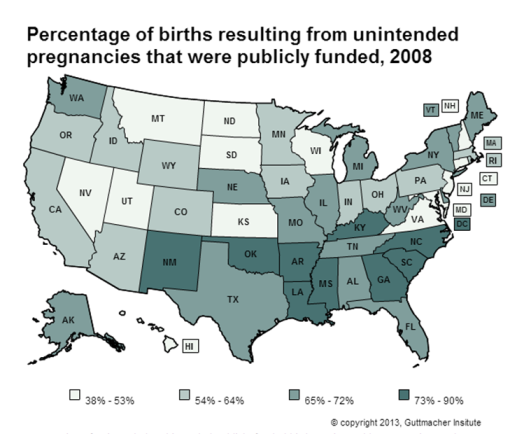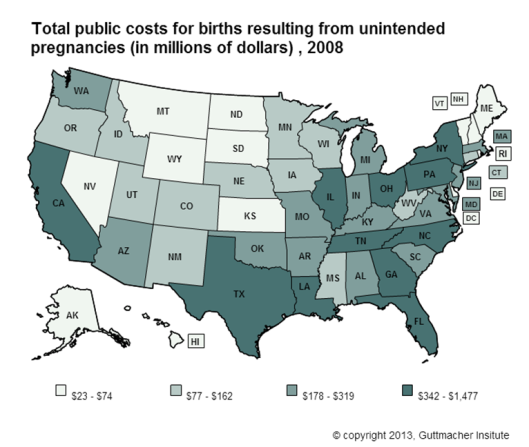Nationally, two out of every three births resulting from unintended pregnancies, approximately 1.1 million births, were paid for by public insurance programs in 2008, according to a new Guttmacher report by Adam Sonfield and Kathryn Kost. Public expenditures on these births—including costs of prenatal care, labor and delivery, postpartum care and one year of care for the infant—totaled $12.5 billion in 2008. These births accounted for 53% of all publicly funded births that year.

"Our report demonstrates the continuing importance of Medicaid and other public health insurance programs in helping U.S. women and families afford the expense of pregnancy and childbirth," says Adam Sonfield, co-author of the new report. "It also shows that, in addition to the health, social and economic consequences of unintended pregnancies for women and families, federal and state governments incur significant costs as a result of these pregnancies."
The report also puts into context the significant savings that result from averting unintended pregnancies and subsequent births through publicly supported family planning services. Earlier Guttmacher Institute research found that current public investments in family planning services helped avert $12.7 billion in gross costs related to unintended pregnancies in 2010. In the absence of that investment, the annual public costs of births from unintended pregnancy would double, to more than $25 billion.
Among the report's key findings:
- Nationally, 65% of the 1.7 million births resulting from unintended pregnancies in 2008 were paid for by public insurance programs (Medicaid, the Children's Health Insurance Program and the Indian Health Service), compared with 48% of all births and 36% of births resulting from intended pregnancies.
- There were 2.0 million publicly funded births in 2008; of those, 1.1 million, or 53%, resulted from unintended pregnancies; by comparison, 1.7 million out of 4.2 million births nationwide—39%—resulted from unintended pregnancies.
- In 15 jurisdictions, at least 70% of births resulting from unintended pregnancies were paid for by public programs. Mississippi was the state with the highest proportion (83%). All but three of those 15 jurisdictions are in the South (as categorized by the U.S. Census Bureau), a region with high levels of poverty.
- Of the $12.5 billion in government expenditures on births resulting from unintended pregnancies in 2008, $7.3 billion were federal expenditures and $5.2 billion were state expenditures.
- In seven states, public costs related to births from unintended pregnancies exceeded half a billion dollars. California ($1.5 billion) and Texas ($1.3 billion) spent the most.

The role of public health insurance programs in paying for U.S. births is likely to expand further as the Affordable Care Act's major expansion to Medicaid eligibility begins in 2014.
"Reducing the $12.5 billion in public costs for births resulting from unintended pregnancies requires substantial new public investments in family planning services and comprehensive sex education," says Sonfield. "The Affordable Care Act is a big step in the right direction, with its expansions of public and private insurance coverage and the requirement that most private health plans cover the full range of contraceptive methods and services without out-of-pocket costs."
But the report's authors warn that chronic underinvestment and ideological attacks on the programs and providers that make publicly supported family planning services accessible to millions of women have been counterproductive. For instance, appropriations for the Title X national family planning program are 67% lower today than they were in FY 1980, adjusted for inflation. Shortsighted cuts to highly successful family planning programs may actually end up increasing public expenditures, the report concludes.
Full report:
"Public Costs from Unintended Pregnancies and the Role of Public Insurance Programs in Paying for Pregnancy and Infant Care: Estimates for 2008," by Adam Sonfield and Kathryn Kost
For more information:
Data Center: Create a map or table (Public Expenditures on Births, under Services and Financing)
Video: Publicly Supported Family Planning Services Are Essential
Video: The Benefits of Contraceptive Use in the United States
Fact sheet: Facts on Unintended Pregnancy in the United States
Fact sheet: Facts on Publicly Funded Contraceptive Services in the United States
Fact sheet: State Facts About Title X and Family Planning
Fact sheet: State Facts About Unintended Pregnancy
Analysis: Besieged Family Planning Network Plays Pivotal Role
Analysis: Documenting the Social and Economic Benefits of Family Planning
Research: The Health Benefits of Services Provided at Family Planning Centers
Research: Contraceptive Needs and Services, 2010
If you find this information useful, please consider supporting our work